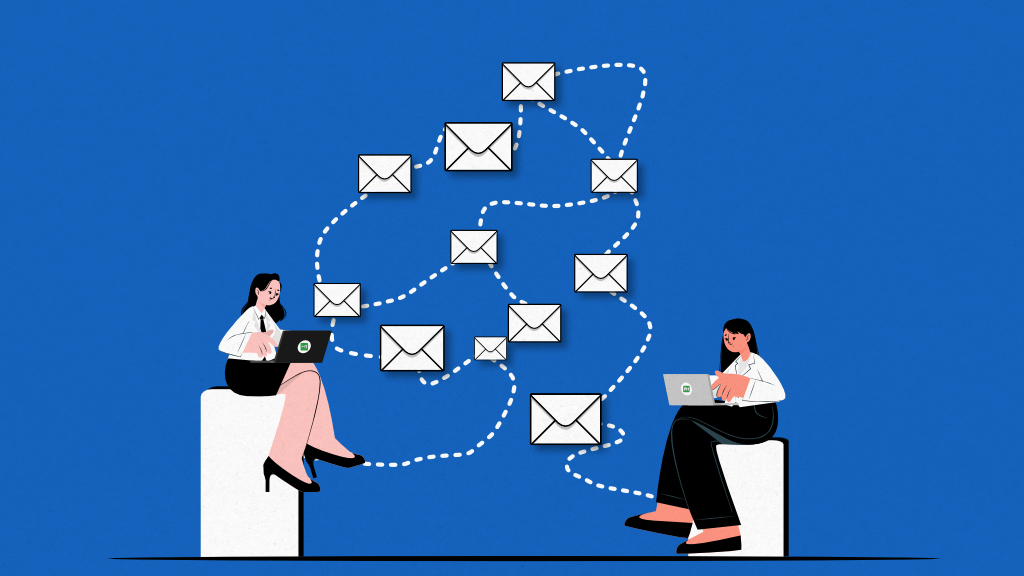Introduction
Imagine email notifications flashing on your screen…again and again.
Each time, you hope it’s finally the information you need to end this back-and-forth email cycle, but it never is.
This repetitive cycle puts your time, focus, efficiency, and most importantly productivity at stake.
Being a manager, you just can’t afford it.
Let’s find out the ways to cut down on directionless email threads and build a culture where communication flows actively and sparingly.
But before that, it’s important to know what are back-and-forth emails, how to reduce them, and what are the benefits of reducing them.
What are back-and-forth emails?
Back-and-forth emails are a series of emails between two or more people to clarify information, ask questions, or solve issues. They usually happen when the initial emails do not have enough information and clarity.
These emails waste a lot of time. People spend a lot of time exchanging emails for something that could have been done with a simple and clear message at first. These emails also lead to confusion and frustration, if important information gets lost in the chain of messages. By writing clear and complete information, you can avoid these long conversations.
Why are back-and-forth emails bad?
Let’s be honest – emails have their place, but excessive emailing doesn’t. It’s easy to get stuck in the loop of messages, and the moment you will realize it, it will be too late to escape the overwhelm.
According to a citation in Email Characteristics, Work Performance, and Distress Study – “Several studies have shown that frequent email interruptions and high connectivity can instigate work overload, time pressure, job dissatisfaction, work disengagement, stress and feelings like anger and sadness. (Barley et al., 2011; Derks et al., 2021; Jerejian et al., 2013; Mano and Mesch, 2010; Sonnentag et al., 2018; Ten Brummelhuis et al., 2012).“
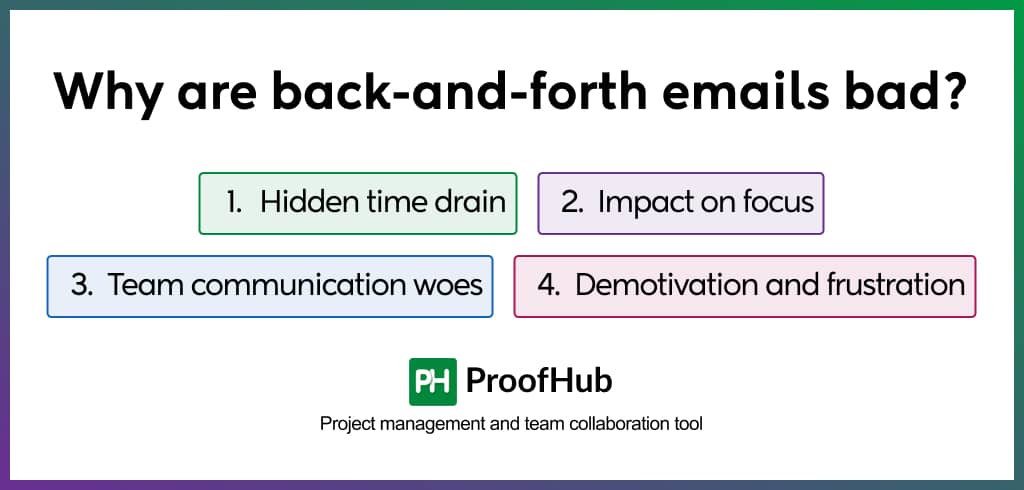
Let’s look at how it impacts you and your workability:
1. Hidden time drain
High-volume emails are significant time eaters. You open your email inbox intending to come out of it quickly. But as you delve deeper, you see hours of hours gone by. The constant email influx disrupts your focus, stealing valuable time that otherwise would have gone into something essential and productive.
2. Impact on focus
Switching between emails and other tasks makes you easily lose sight of more substantial, meaningful tasks. Not only that, the constant interruption hinders deep work and even plagues your progression. This shift in attention causes lower-quality work and delayed task accomplishment.
3. Team communication woes
No doubt, email can deliver your words across distances, but do they claim to convey context and intention too? Definitely not. Why? Because it lacks the non-verbal cues that form a significant part of professional communication exchange. This can fan the fire of misunderstandings and miscommunications within teams.
4. Demotivation and frustration
With the already significant work on your tasks, the constant demand for your attention can potentially stall your projects. You may feel overwhelmed and experience burnout quickly. This influx of messages turns into a never-ending loop in no time.
6 best practices to reduce back-and-forth emails
If you often find yourself struggling to deal with endless email threads, it’s high time to bring it to a close. Here are some effective ways to improve your email communication and reduce back-and-forth emails:
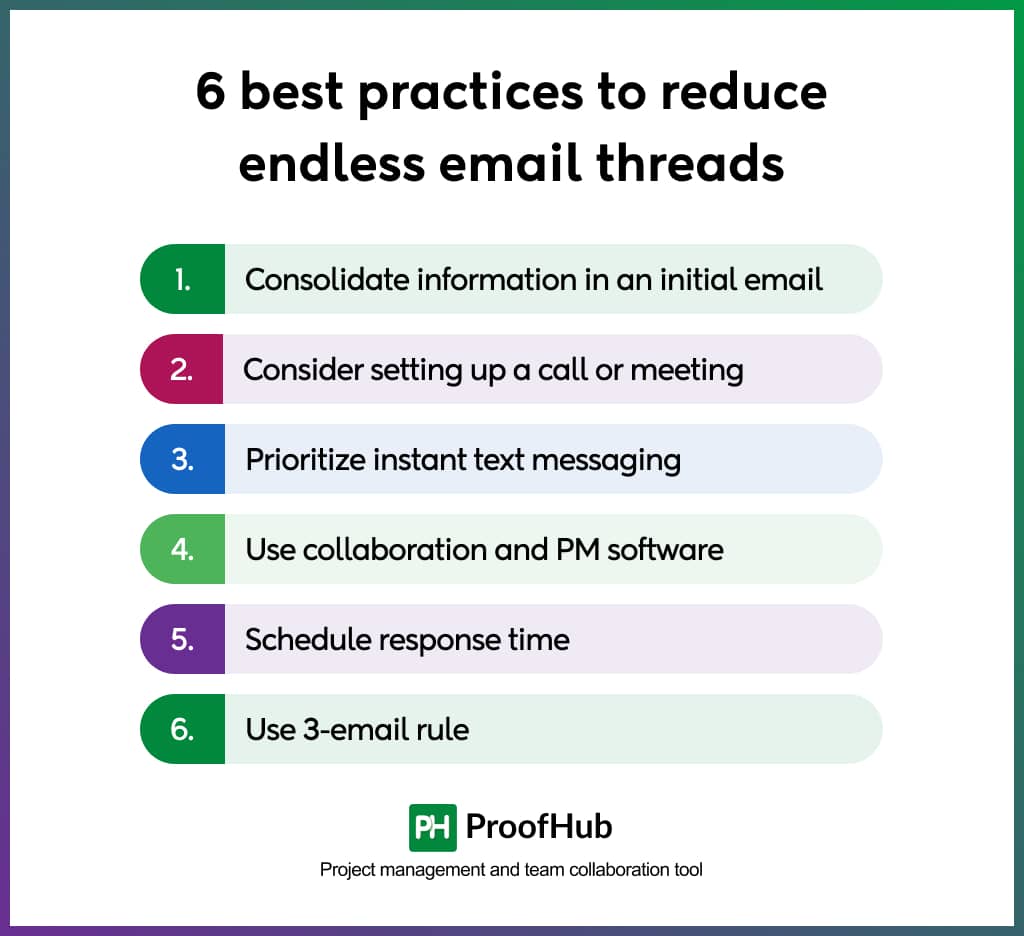
1. Consolidate information in an initial email
Begin with comprehensive details, no matter how trivial they may seem. Don’t leave any scope for wondering and speculating. Break down complex ideas, explain email history (if any), and avoid technical jargon to keep your communication crisp.
Draft your email with clarity and completeness, but never close a door permanently. Leave a clear pathway for further clarification.
2. Consider setting up a call or meeting
The moment you see an email trap becoming inefficient cut it down. Change your approach to a less-email-heavy strategy. Either hop on a call (if it’s a simple matter) or schedule a meeting (if it is complex) to clarify your concerns and resolve issues in real-time.
“People feel significantly more connected through voice-based media, but they have these fears about awkwardness that are pushing them towards text-based media,” – Amit Kumar, a McCombs School of Business assistant professor of marketing, co-author with Nicholas Epley of the University of Chicago.
Learn effective email time management tips to spend less time on emails and limit your visits to your inbox
3. Prioritize instant text messaging
Emails lack the immediacy that faster communication methods like text messages and DMs provide. These methods become even more valuable when you don’t have time to jump on a call or meeting. Also, with the influx of the Gen Z workforce becoming dominant, even the biggest of leaders are adapting to new communication platforms.
Thierry Delaporte, the CEO of Wipro says, “They’re 25, they don’t care. They don’t go on their emails, they go on Snapchat, they go on all these things.” He even claims that he himself has started using Instagram and LinkedIn to communicate efficiently with his Gen Z staffers in conversation with the Daily Telegraph.
4. Use collaboration and project management software
According to a survey of more than 1,000 IT decision-makers, 51% of them prefer utilizing “real-time business chat apps” over email.
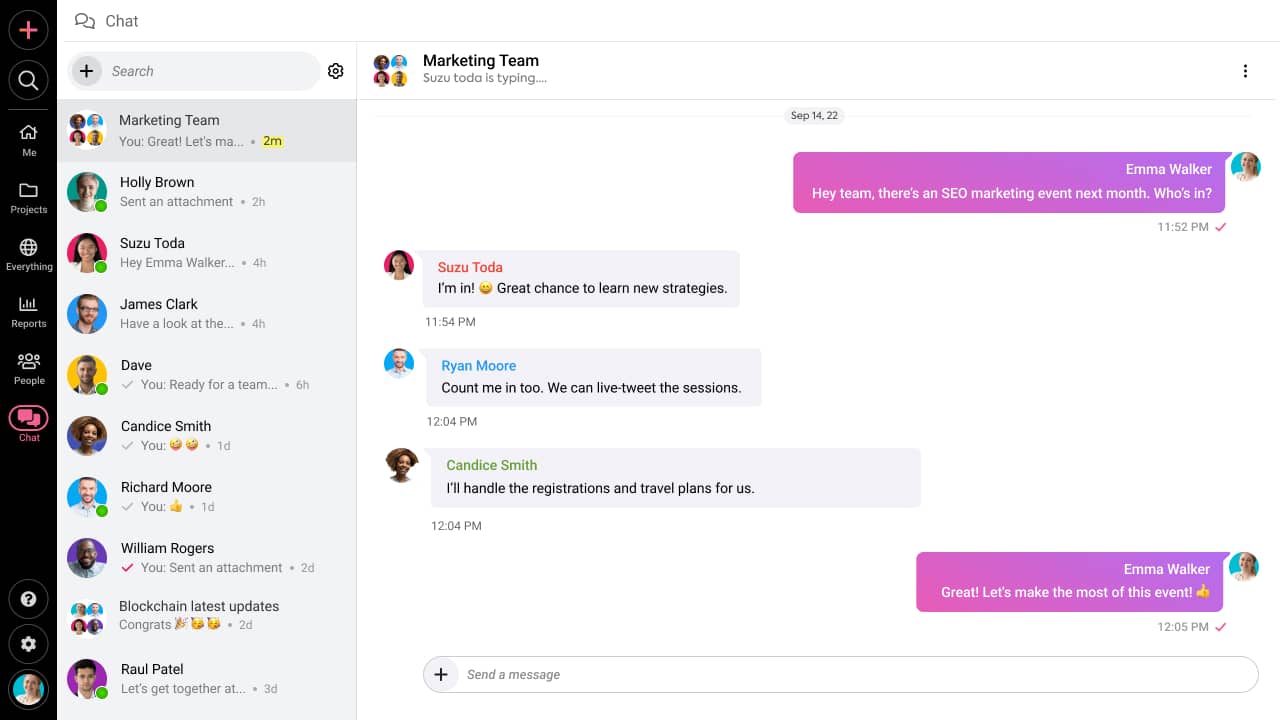
Use instant built-in chat and skip emails for swift communication with ProofHub
Use project management and collaboration tools like ProofHub, with its real-time online chat, you can avoid lengthening the string of replies. You can have one-on-one conversations, group chat rooms, and even discussions in one centralized platform.
Replacing emails with PM tools can enhance your collaboration efficiency and not seem cluttered or overwhelming.
5. Schedule response time
Sorting through a barrage of emails from morning to evening isn’t a good practice. Neither practical nor efficient. So, creating an appropriate response window is crucial to managing email risk. Do not stay 24/7 active in checking your email inbox. Set a particular time and duration for email checks. For better time management, set a reminder and schedule your emails.
6. Use 3-email rule
Being pulled apart between different things, resist yourself from drafting a quick email response. Instead, follow the 3- email rule in your email marketing strategy. It is a productivity technique to reduce the number of email exchanges to 3. It means, that if you exceed 3 emails without reaching any resolution, take the conversation to some other medium.
Email etiquette for improved communication
Learning the undefined protocols of composing professional emails is crucial to reflect your professionalism in emails. Let’s uncover all of them.
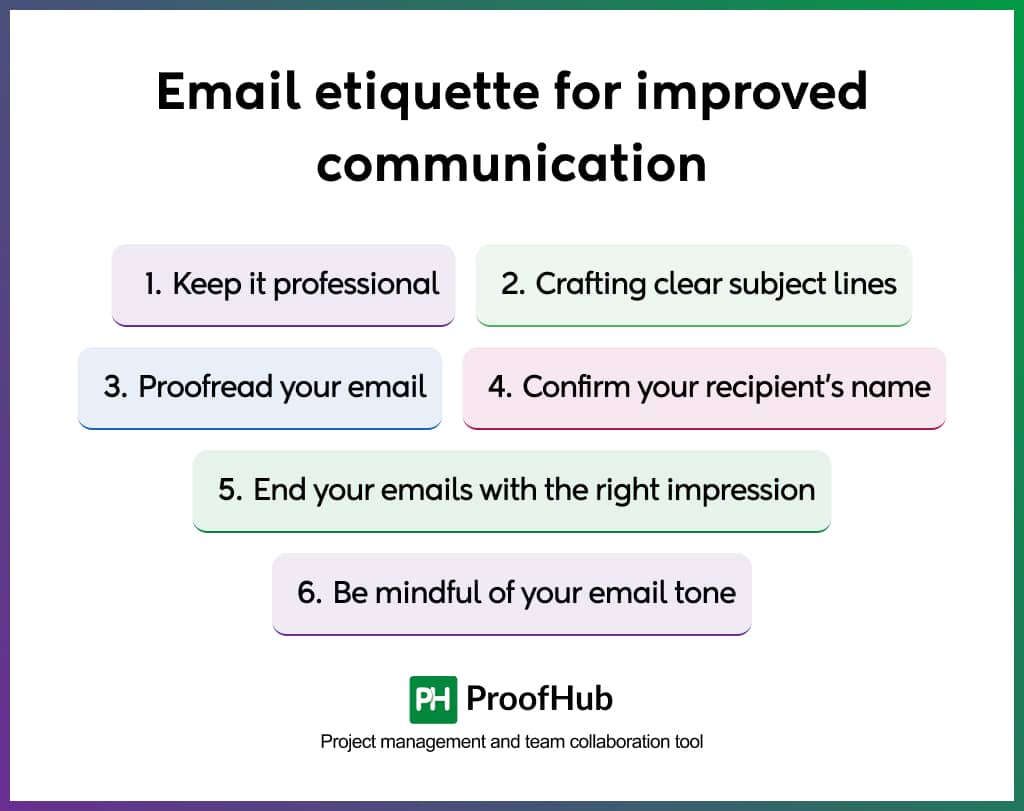
1. Keep it professional and concise
Do not go extravagant when writing emails. Be formal and precise when communicating with your teammates. Make sure to set a certain limit to characters and avoid fluff.
For example, you can write –
Could you please provide a detailed update on the current status of [specific project/task]? It would be helpful to understand the recent progress and any upcoming milestones or potential challenges.
Instead of
“What is the current task status?”
2. Crafting clear subject lines
A descriptive subject line increases the likelihood of your email being clicked. According to research by SuperOffice, 33% of email recipients consider the subject line before opening an email.
For example, using a subject line stating “ Require Feedback” is quite ambiguous. Instead replace it with “Request: Feedback on Marketing Proposal.” That’s much better and crisp.
3. Proofread your email
Make sure your emails are grammatical error-free. Any typos, punctuation errors, or inappropriate salutations, leave a negative impression on the recipient. Use spell-check features and do self-proofreading before hitting send.
❌ Incorrect: “The team’s performance has improved significantly however, there’s still room for growth.”
✅ Correct: “The team’s performance has improved significantly; however, there’s still room for growth.”
4. Confirm your recipient’s name
The biggest pillar of learning email etiquette is knowing your recipient. You lose credibility the moment you misspell your recipient’s name or write the wrong name. So, take two minutes out of your time to double-check your recipient’s name and ensure you spell it right.
For example,
- Michael as Micheal
- Sarah as Sara
5. End your emails with the right impression
Your email sign-off should be polite. Since it’s the last thing your recipient reads before closing it. Use a professional closing salutation followed by your full name and title.
Some professional sign-offs include:
- Have a wonderful [day, weekend]
- Regards
- Best regards
- Thank you for your time
6. Be mindful of your email tone
While it is hard to communicate your tone across email, you should be considerate of your email tone. Avoid negative phrases, sarcasm, casual language, and emotional outbursts. Remember, emails lack non-verbal communication cues, increasing the chances of being misinterpreted and even getting offended.
Learn effective email project management tips to overpower email overload
What are the benefits of reducing back-and-forth emails?
Emails are an essential part of work, but excessive back-and-forth emails can waste time and reduce productivity. Emails with clear and simple messages can improve understanding and thus increase team productivity. Here are some benefits of reducing back-and-forth emails:
1. Saves time
Too many emails can eat your day and you have very little time for other activities. By reducing unnecessary back-and-forth email saves you time which you can use for other tasks. A simple and well-written email eliminates the time of follow-ups and saves time for everyone involved.
2. Improves clarity
Back-and-forth emails often result in incomplete communication. When you aim to reduce the number of exchanges, you need to keep your message clear and defined. Having clear messages reduces misunderstanding and improves clarity in teams.
3. Increase productivity
Back-and-forth emails can be a major distraction from deep, focused work. By reducing back-and-forth emails you can focus on tasks that truly matter. This leads to increased productivity and a sense of accomplishment at the end of the day.
4. Reduces stress
A cluttered inbox can be stressful when it’s filled with repetitive or unnecessary emails. By cutting down on back-and-forth, you can keep your inbox manageable. A cleaner inbox contributes to a clearer mind and reduces stress.
5. Enhances decision-making
Long email threads can slow down your decision-making process. Consolidating all necessary information in emails ensures that decisions can be made quickly and effectively, without the need for long clarifications and discussions.
Encourage a culture of efficient collaboration with ProofHub
Effective communication forms one of the strongest pillars of a successful organization.
Sending and responding to emails are considered productive initially. But modern workplace dynamic has raised questions on its efficiency.
To overcome this issue, you should incorporate a real-time project management and collaboration tool like ProofHub. It is a one-stop solution for all your project needs. From facilitating seamless communication to staying on top of project updates, it eliminates the need for email exchange.
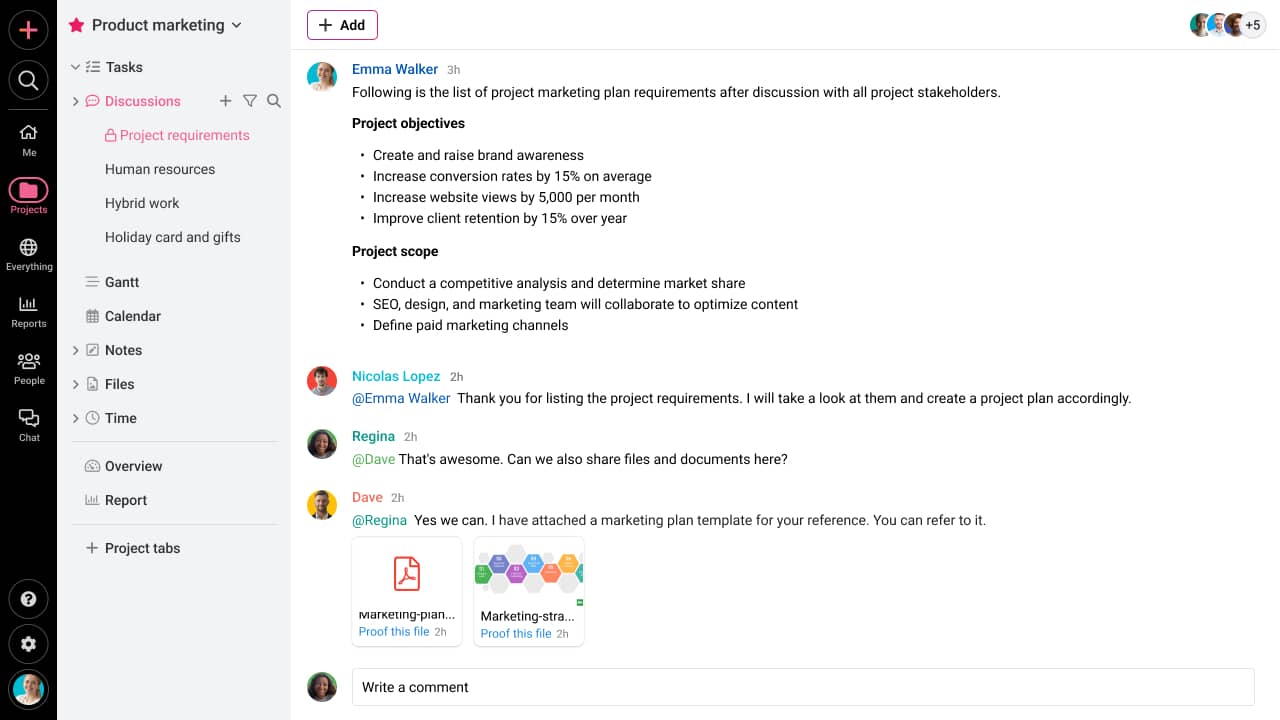
Save your team discussions from turning into endless email threads with centralized exchange
Let’s break down what you can do with ProofHub:
- You can define clear project goals, roles, and communication protocols.
- You can see all project activity at a glance using Gantt charts and Kanban boards.
- You can keep everyone on the same page by creating shared understanding for everyone.
- You can ask quick questions or updates using real-time chat and provide feedback on digital assets using online proofing.
- You can draw your teammate’s attention to a particular task, discussion, or file using @mentions.
- You can keep project-related conversations organized and accessible in one location.
- You can remove the ambiguity from your team dynamics by assigning tasks, setting deadlines, and tracking progress.
- You can uncover bottlenecks and areas of improvement using insightful reporting features.
- You can save time and ensure consistency by using pre-defined templates.
ProofHub is one of the smarter email alternatives that help streamline communication, boost productivity, and revolutionize your team collaboration
Note: If emails are your go-to tools and you can’t help using these, don’t worry. ProofHub’s email-in tasks allow you to add tasks, comments, and files from within the email. This means you can still get an email-like feel while using the comprehensive solution for your projects.
FAQs
What are the best practices for a clear subject line in an email?
For a clear email subject line, be specific and concise, and highlight the key point. Avoid jargon or all caps. If it is time-sensitive, include urgency but keep it professional.
How do I ensure that my emails lead to faster decision-making?
To ensure your emails lead to faster decision-making, be clear about the decision you need. Provide all relevant information and suggest specific options or next steps. Use bullet points to focus key points, and set a deadline for a response.
How do you politely end an email chain?
There are different ways you can give a polite end to your email conversation and avoid future clarification emails –
- Summarize the key takeaways or briefly mention the next steps in your email.
- Use professional closing salutations and phrases that indicate the conversation ending.
- Avoid one-word responses.
- Move the conversation to another platform if the email chain becomes overly long or repetitive.
- Avoid saying “Re: Re: Re:” in the subject line.
